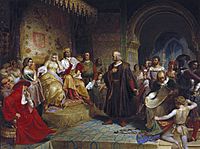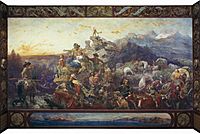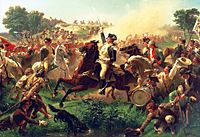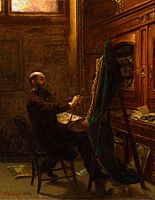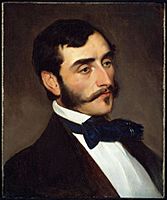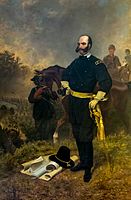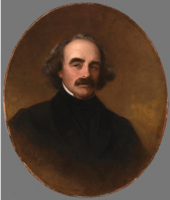Emanuel Leutze facts for kids
Quick facts for kids
Emanuel Leutze
|
|
|---|---|
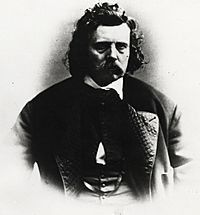
Leutze in a photograph taken before 1868
|
|
| Born | May 24, 1816 Schwäbisch Gmünd, Württemberg, German Confederation
|
| Died | July 18, 1868 (aged 52) Washington, D.C., U.S.
|
| Resting place | Glenwood Cemetery Washington, D.C., U.S. |
| Nationality | German American |
| Education | John Rubens Smith Karl Friedrich Lessing |
| Known for | History painter |
Emanuel Gottlieb Leutze (born May 24, 1816 – died July 18, 1868) was a famous German-American history painter. He is best known for his 1851 painting, Washington Crossing the Delaware. This painting shows George Washington leading his troops across the icy Delaware River. Leutze's art style is linked to the Düsseldorf school of painting.
Contents
Emanuel Leutze's Early Life and Art Training
Emanuel Leutze was born in a town called Schwäbisch Gmünd in Germany. When he was nine years old, in 1825, his family moved to the United States. They first lived in Fredericksburg, Virginia, and then in Philadelphia.
Emanuel's artistic talent first appeared when he was caring for his sick father. He would draw to pass the time during the long hours. His father passed away in 1831. By age 14, Emanuel was already painting portraits. He charged $5 for each one. This work helped him support himself after his father's death.
In 1834, he started his first art classes. He studied with John Rubens Smith, a portrait painter in Philadelphia. Emanuel quickly became very skilled. He even planned to publish portraits of important American leaders. However, he did not get much support for this idea.
Studying Art in Europe
In 1840, one of Leutze's paintings got a lot of attention. This led to several orders for new paintings. These orders gave him enough money to travel to Germany. He went to the Kunstakademie Düsseldorf, an art academy in his home country.
He only studied there for one year. He was more influenced by the painter Karl Friedrich Lessing. In 1842, Leutze traveled to Munich. There, he studied the works of famous artists like Peter von Cornelius. While in Munich, he finished his painting Columbus before the Queen.
The next year, he visited Venice and Rome in Italy. He studied the art of masters like Titian and Michelangelo. His first major work, Columbus before the Council of Salamanca (1841), was bought by an art group in Düsseldorf. Another painting, Columbus in Chains, won him a gold medal. It was later used on a $2 stamp in 1893.
In 1845, after his trip to Italy, Leutze went back to Düsseldorf. He married Juliane Lottner and lived there for 14 years.
Life in Düsseldorf and Famous Paintings
During his time in Düsseldorf, Leutze helped many American artists who visited. He found them places to live and work. He also introduced them to people and gave them support. For many years, he was the leader of the Düsseldorf Artists' Association. He also helped start the "Malkasten" art association in 1848.
Leutze strongly supported the Revolutions of 1848 in Europe. These were times of big political changes. He decided to paint a picture that would inspire people in Europe. He wanted to show them the example of the American Revolution.
He used American tourists and art students as models for his painting. Leutze finished the first version of Washington Crossing the Delaware in 1850. Soon after it was done, the painting was damaged by a fire in his studio. It was repaired and bought by a museum in Bremen, Germany. Sadly, this first version was destroyed in a bombing during World War II in 1942.
A second, larger version of the painting was ordered in 1850. It was shown in New York in 1851. This famous painting is now at the Metropolitan Museum of Art in New York City. In 1854, Leutze finished another painting, "Washington rallying the troops at Monmouth." This painting showed the Battle of Monmouth.
Working in the United States
In 1859, Leutze moved back to the United States. He opened an art studio in New York City. He spent his time working in both New York City and Washington, D.C..
In 1859, he painted a portrait of Chief Justice Roger Brooke Taney. This painting is now at Harvard Law School. A judge once described the portrait as showing Taney with "profound sadness and disillusionment."
Leutze also painted other portraits. One was of his fellow painter William Morris Hunt. This portrait was shown at an art exhibition in Boston in 1878.
In 1860, the U.S. Congress asked Leutze to decorate a stairway in the United States Capitol Building. For this, he painted a large artwork called Westward the Course of Empire Takes Its Way. It is also known as Westward Ho!.
Later in his life, he became a member of the National Academy of Design. He was also part of the Union League Club of New York, which owns several of his paintings. Emanuel Leutze died in Washington, D.C., at age 52. He passed away from heat stroke. He was buried in Glenwood Cemetery. At the time of his death, he was working on a painting called The Emancipation of the Slaves.
Leutze's portraits are known for their artistic quality. They also show a love for his country. Washington Crossing the Delaware is one of the most famous American paintings. It is a national symbol.
Gallery of works
-
Christopher Columbus before the Queen (1843)
-
Washington Rallying the Troops at Monmouth (c. 1851-1854)
-
William H. Seward and Eduard de Stoeckl Negotiating the Alaska Purchase (1867)
-
Portrait of William Morris Hunt (ca. 1845)
-
General Ambrose Burnside at Antietam (1863)
-
Nathaniel Hawthorne (1862)
-
Political Cartoon of the American Civil War, c. 1860s, National Gallery of Art
Images for kids
See also
 In Spanish: Emanuel Gottlieb Leutze para niños
In Spanish: Emanuel Gottlieb Leutze para niños


